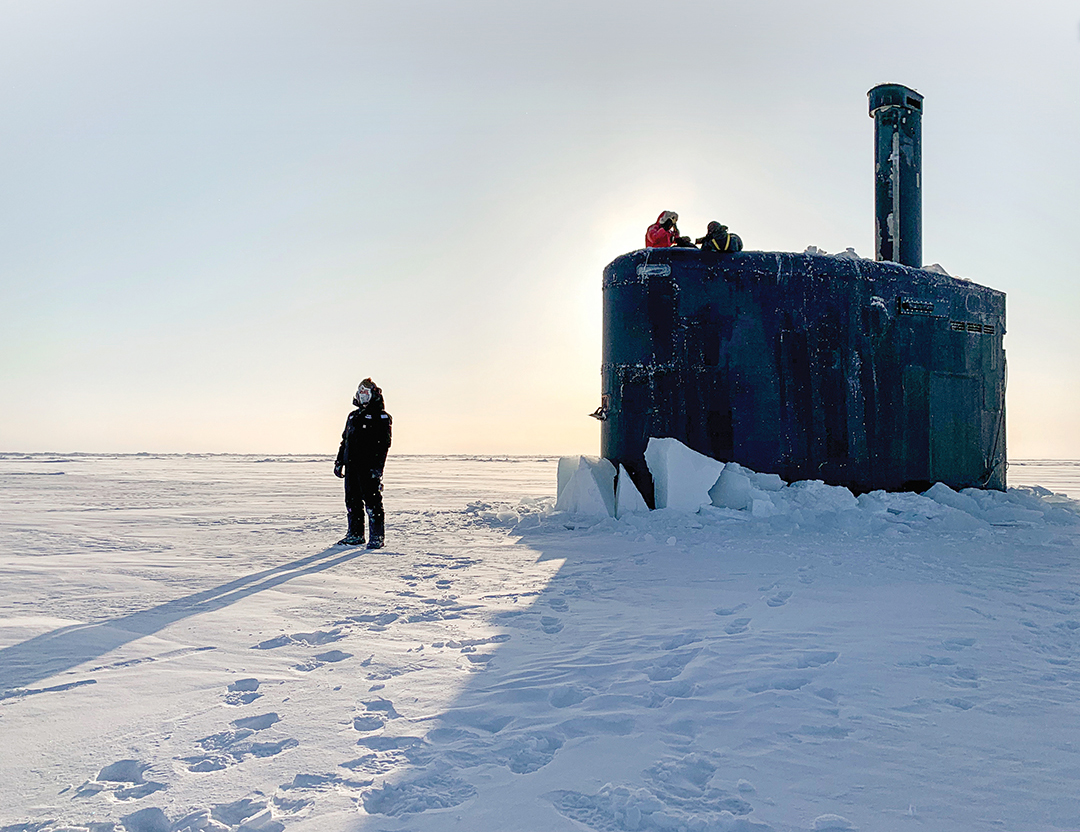Great power competition in the Arctic
By Lt. Col. Ryan B. Ley, U.S. Air Force, senior U.S. fellow at the Marshall Center
Historically, the Arctic has been considered “high north, low tension.” While the immediate prospect of conflict remains low, a number of indicators point to how the Arctic may be heating up, literally and figuratively. In a literal sense, climate change is causing the Arctic to heat up at a rate twice as fast as the global average. The resulting loss of sea ice allows increasingly open access to navigation and natural resources.
Russia seeks to exploit these resources — oil and natural gas, in particular — forecasting a growth in the Arctic share of its gross domestic product from 7.2% to 9.6% over the next 15 years, according the Russian ambassador to Iceland, Anton Vasiliev. Militarily, Russia has been reinforcing its 24,000-kilometer Arctic coastline since 2007. China, declaring itself a “near-Arctic state,” primarily exhibits economic aspirations and seeks to internationalize the Arctic to ensure access for the development of its “Ice Silk Road.”
In response to increased access and growing competition, the U.S. Department of Defense (DOD) released a new Arctic Strategy in 2019 to reinforce its commitment to the High North. This renewed interest and evolving security environment in the Arctic is creating a new frontier for great power competition.
Informed by the current 2017 National Security Strategy and the 2018 National Defense Strategy, the 2019 DOD Arctic Strategy defines the department’s desired end state in the Arctic as “a secure and stable region in which U.S. national security interests are safeguarded, the U.S. homeland is defended, and nations work cooperatively to address shared challenges.” It outlines three strategic ways to support this end state: building Arctic awareness, enhancing Arctic operations and strengthening the rules-based order in the Arctic. Furthermore, the document declares that the “cornerstone” of the strategy and the U.S.’s greatest strategic advantage is its network of allies and partners with shared national interests in a rules-based order. These strategic concerns provide the framework for this edition of per Concordiam.
The DOD Arctic Strategy describes a complex Arctic security environment that includes many positive, cooperative trends as well as an increasing number of uncertain, problematic trends. The most notable positive trend is that Arctic nations have historically sought multilateral cooperation to address shared interests and challenges in the region while isolating them from wider geopolitical conflicts. International agreements on scientific research, maritime traffic and environmental issues represent the multilateral cooperation needed to address the challenges associated with human and economic activity in the harsh Arctic environment. The Arctic Council, composed of eight nations with sovereign territory in the Arctic, provides the framework for multilateral cooperation. The U.S. maintains strong defense relationships with six of the seven other Arctic nations — four NATO allies (Canada, Denmark (Greenland), Iceland and Norway) and two NATO Enhanced Opportunities Partners (Finland and Sweden). Russia is the seventh. In May 2021, Russia began its two-year chairmanship of the Arctic Council and thus began a new chapter in Arctic cooperation.

The uncertainty in the Arctic security environment begins with the changing physical environment induced by climate change, which is likely to physically open the region to increased great power competition. Rapidly increasing temperatures across the Arctic result in diminished sea ice and snow coverage, thawing permafrost, and loss of ice sheets and glacier mass. During the summer months, declining sea ice coverage opens new shipping lanes that had previously been unnavigable and allows access to natural resources previously unattainable. At the current rate, Arctic-wide sea-ice loss may result in ice-free late summers by the 2040s, according to the DOD Arctic Strategy. Thawing permafrost has adverse effects on existing infrastructure and complicates the development of new and resilient infrastructure. The changing physical characteristics are even causing some Arctic communities to relocate. Despite the overall warming trend, harsh conditions in the Arctic persist, including extreme cold temperatures and sustained darkness, which impose specific requirements for sustaining military capabilities in the region.
Among the geopolitical ramifications of the changing physical environment is the status of Arctic sea routes and territorial waters. Both Russia and Canada claim the right to regulate Arctic waters, exceeding the authority permitted under international law. Before entering the Northern Sea Route (NSR), foreign vessels are required to obtain Russian permission and travel under escort of its icebreakers. Russia has also threatened the use of force against foreign vessels that disregard its regulations. Canada, for its part, claims the Northwest Passage as internal waters, and therefore subject to Canadian rules and regulations. As lines of longitude converge at the North Pole, so do the geopolitical lines drawn by the Arctic states. According to the NATO Parliamentary Assembly Political Committee report, “NATO and Security in the Arctic (2017),” one of the main ongoing maritime delimitation disputes revolves around claims to the underwater Lomonosov Ridge and involves Russia, Canada and Denmark (Greenland). This and other territorial disputes in the Arctic are reviewed under the framework of the United Nations Convention on the Law of the Sea, which allows countries to claim an exclusive economic zone of 200 nautical miles beyond their shoreline. Additionally, states are granted exclusive rights to exploit mineral resources on their continental shelves up to a distance of 350 nautical miles from the baselines.

Naturally, increased access and expanded claims on territorial waters elicit increased military activity. Russia is the largest Arctic nation by landmass, population and military presence north of the Arctic Circle. Outnumbered 7 to 1 in the Arctic Council by Western allies and partners, Russia seems compelled to defend itself as a polar great power. It has matched its increases in commercial investments with increases in defense investments and activities for territorial defense and control of the NSR. By no coincidence, Russia formed the Northern Fleet Joint Strategic Command in December 2014, after relations with the West deteriorated over Russian incursions in Ukraine. Deployment of new Arctic units followed, along with refurbishing of old airfields and infrastructure, and creation of new military bases along the Arctic coastline. The DOD Arctic Strategy also notes that Russia has made a concerted effort to establish a network of air defense and coastal missile systems, early warning radars, and search and rescue centers. By comparison, China’s military presence in the Arctic has been limited. However, the dual-use nature of its ice-breaking vessels and scientific research centers could support a future military presence, including the deployment of submarines.
Despite having no territorial claims in the region, China has asserted itself to be a “near-Arctic state” and is seeking a role in Arctic governance. According to the DOD, the U.S. does not recognize this status, although China has been granted observer status in the Arctic Council since 2013. In its first Arctic policy white paper in January 2018, China linked its economic activities in the Arctic to its broader strategic objectives as part of its “One Belt, One Road” program (aka “Ice Silk Road” in the Arctic). Its stated interests in the region are focused on natural resources and Arctic sea routes for Chinese shipping. Though China does not have a military presence in the Arctic, it is increasing its presence through economic outreach, investments in the strategic sectors of Arctic states and scientific activities. For example, China maintains scientific research stations in Norway and Iceland and is pursuing energy development and infrastructure projects on Russia’s Yamal Peninsula. It also continues to invest in dual-use infrastructure in the Arctic, signaling China’s willingness to protect its growing interests and investments in the region.
In summary, access to the Arctic is opening up a new frontier for great power competition, and China and Russia appear to have a head start. Perhaps more compelling, they are publicly showcasing their willingness to cooperate with one another. The 2017 China-Russia Joint Statement on Further Strengthening Comprehensive, Strategic and Cooperative Partnership specifically mentions cooperation in the Arctic fields of transport, scientific research, energy resources, tourism and environmental protection. After the release of the 2019 DOD Arctic Strategy, the U.S. Air Force and U.S. Navy each released its respective strategy and blueprints for the region. Fortunately, the U.S. is not alone. NATO and the European Union, and their individual member states, recognize the strategic implications of Russian and Chinese endeavors in the Arctic and have likewise increased strategic dialogue in recent years. But is it too late? The question remains whether Western democracies have the resources, solidarity and fortitude to uphold the balance of power in the High North.


Comments are closed.